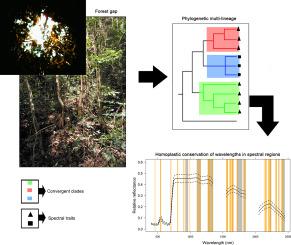当前位置:
X-MOL 学术
›
Remote Sens. Environ.
›
论文详情
Our official English website, www.x-mol.net, welcomes your
feedback! (Note: you will need to create a separate account there.)
Phylogenetic signatures in reflected foliar spectra of regenerating plants in Neotropical forest gaps
Remote Sensing of Environment ( IF 11.1 ) Pub Date : 2021-02-01 , DOI: 10.1016/j.rse.2020.112172 Écio Souza Diniz , Cibele Hummel Amaral , Silas Tadin Sardinha , Jan Thiele , João Augusto Alves Meira-Neto
Remote Sensing of Environment ( IF 11.1 ) Pub Date : 2021-02-01 , DOI: 10.1016/j.rse.2020.112172 Écio Souza Diniz , Cibele Hummel Amaral , Silas Tadin Sardinha , Jan Thiele , João Augusto Alves Meira-Neto

|
Abstract Spectroscopy can be used to investigate ecosystem functioning and phylogenetic relationships, since it can provide information about the optical properties of a plant – a critical functional trait with regard to light usage. The link between phylogenetic relationships and foliar reflectance spectra of Neotropical species has rarely been considered and no previous studies have explored this in relation to forest regeneration following natural gap formation. We investigated phylogenetic signatures, i.e. evolutionary conservation, of foliar spectra in gap-regenerating woody species in conserved Neotropical forests. We collected foliar spectra of 53 regenerating woody species in the forest gaps at two sites of Atlantic Seasonal Semi-deciduous forest, and quantified the phylogenetic signal for spectral wavelengths using Blomberg's K, Pagel's lambda (λ) and LIPA (Local indicator of phylogenetic association) statistics. Analysis of foliar reflectance spectra showed that the largest portion of phylogenetic signature from both K and λ occurred within the first part of the shortwave infrared region (SWIR-1: 1551–1849 nm), followed by the near infrared (NIR: 701–1349 nm), and the lowest portion within the visible region (VIS: 400–700 nm). Most of the significant phylogenetic signal found for wavelengths of all spectral regions suggested convergent conservation, i.e. homoplasy. The largest portion of positive LIPA (i.e. phylogenetic similarity) was found for wavelengths within the second part of the SWIR (SWIR-2: 2051–2450 nm), while most of the negative LIPA (i.e. phylogenetic distinctiveness) occurred within the VIS. We conclude that there is a tendency towards evolutionary convergence in the phylogenetic signature of foliar spectra in certain parts of the spectrum. The extent of phylogenetic signal found in the SWIR allows us to conclude that this region carries the most potential for future investigations of phylogenetic influence on spectral community dynamics within Neotropical forests.
中文翻译:

新热带林隙再生植物反射叶谱的系统发育特征
摘要 光谱学可用于研究生态系统功能和系统发育关系,因为它可以提供有关植物光学特性的信息 - 与光利用相关的关键功能特性。新热带物种的系统发育关系和叶面反射光谱之间的联系很少被考虑,以前的研究也没有探讨这与自然间隙形成后森林再生的关系。我们研究了新热带森林中间隙再生木本物种的叶谱的系统发育特征,即进化保护。我们收集了大西洋季节性半落叶林两个地点林隙中 53 种再生木本物种的叶谱,并使用 Blomberg's K 量化光谱波长的系统发育信号,Pagel 的 lambda (λ) 和 LIPA(系统发育关联的本地指标)统计。叶面反射光谱分析表明,来自 K 和 λ 的系统发育特征的最大部分发生在短波红外区域的第一部分(SWIR-1:1551-1849 nm),其次是近红外(NIR:701-1349) nm),以及可见光区域内的最低部分(VIS:400-700 nm)。在所有光谱区域的波长中发现的大多数重要的系统发育信号表明收敛守恒,即同质性。在 SWIR 的第二部分(SWIR-2:2051-2450 nm)内的波长中发现了最大部分的正 LIPA(即系统发育相似性),而大多数负 LIPA(即系统发育独特性)发生在 VIS 内。我们得出结论,在光谱的某些部分,叶光谱的系统发育特征有进化趋同的趋势。SWIR 中发现的系统发育信号的范围使我们能够得出结论,该区域具有未来研究新热带森林内光谱群落动态的系统发育影响的最大潜力。
更新日期:2021-02-01
中文翻译:

新热带林隙再生植物反射叶谱的系统发育特征
摘要 光谱学可用于研究生态系统功能和系统发育关系,因为它可以提供有关植物光学特性的信息 - 与光利用相关的关键功能特性。新热带物种的系统发育关系和叶面反射光谱之间的联系很少被考虑,以前的研究也没有探讨这与自然间隙形成后森林再生的关系。我们研究了新热带森林中间隙再生木本物种的叶谱的系统发育特征,即进化保护。我们收集了大西洋季节性半落叶林两个地点林隙中 53 种再生木本物种的叶谱,并使用 Blomberg's K 量化光谱波长的系统发育信号,Pagel 的 lambda (λ) 和 LIPA(系统发育关联的本地指标)统计。叶面反射光谱分析表明,来自 K 和 λ 的系统发育特征的最大部分发生在短波红外区域的第一部分(SWIR-1:1551-1849 nm),其次是近红外(NIR:701-1349) nm),以及可见光区域内的最低部分(VIS:400-700 nm)。在所有光谱区域的波长中发现的大多数重要的系统发育信号表明收敛守恒,即同质性。在 SWIR 的第二部分(SWIR-2:2051-2450 nm)内的波长中发现了最大部分的正 LIPA(即系统发育相似性),而大多数负 LIPA(即系统发育独特性)发生在 VIS 内。我们得出结论,在光谱的某些部分,叶光谱的系统发育特征有进化趋同的趋势。SWIR 中发现的系统发育信号的范围使我们能够得出结论,该区域具有未来研究新热带森林内光谱群落动态的系统发育影响的最大潜力。











































 京公网安备 11010802027423号
京公网安备 11010802027423号